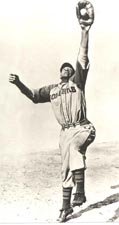 From nlbm.com
From nlbm.com I heard about Buck O'Neil's death from Desmond Howard on College Gameday. You probably wouldn't expect to hear about the passing of one of the last surviving Negro League ballplayers, on a college football pre-game show, but that shows the impact that O'Neil has had as an ambasador for the sport of baseball. Here are the opening paragraphs from the story at mlb.com from the link above:
John "Buck" O'Neil, one of a handful of survivors from the Negro Leagues, grew up too soon to benefit during his life's prime from a country that went on to dismantle the color barrier that stood in front of him.
Yet he'd often tell people, "I was right on time." He'd say his life was absent regrets, and that's a belief that might well be O'Neil's endearing message to others. It should be a message that Americans, black or white, cling to.
Here is a link to the Negro League Baseball Museum in Kansas City, where he played for the Monarchs. O'Neil was the chairman of the museum.
The Kansas City Star has full coverage. Make sure you go to this column by Joe Posnanski. A few excerpts:
The lesson of Buck’s story is that there is always something better — but he had to go out and get it. And he did. He played baseball. He was tall and had good reflexes. So he played first base, first for some semi-professional teams and then for the Kansas City Monarchs of the Negro Leagues. That, he said, was the time of his life.
...
He played baseball with Josh Gibson, one of the great home run hitters who ever lived. Buck used to say that three times in his life he heard a different sound on a baseball field, a crack of the bat that sounded like dynamite. The first time, he was a young boy, and the hitter was Babe Ruth.The last time, he was an old man and a scout and the hitter was former Kansas City Royals star Bo Jackson.
The time in between was Josh Gibson.
...
“Son,” he told Ernie Banks, “you’ve got to love this game to play it.”Ernie Banks would become perhaps the most joyful player in the major leagues. They called him “Mr. Cub” in Chicago. He hit 500 home runs. He was inducted into the Baseball Hall of Fame. He was famous for saying, “It’s a beautiful day. Let’s play two.”
“I learned that from Buck O’Neil,” Banks said.
The column wraps up with the account of Buck O'Neil's greatest day:
It was Easter Sunday, 1943, Memphis, Tenn. The Monarchs were playing the Memphis Red Sox. First time up, Buck hit a double. Second time, he hit a single. Third time, he hit it over the right-field fence. Fourth time up, he hit the ball to left field, it bounced off the wall, and Buck rounded the bases. He could have had an inside-the-park home run, but he stopped at third.
“You know why?” he always asked.
“You wanted the cycle,” I always said.
That night, he was in his room when a friend called him down to meet some schoolteachers who were in the hotel. Buck went down, saw a pretty young woman, and walked right up to her and said, “My name is Buck O’Neil. What’s yours?”
It was Ora. They would be married for 51 years.
“That was my best day,” he said. “I hit for the cycle and I met my Ora.”
“It was a good day,” I said.
“It’s been a good life,” he said.
No comments:
Post a Comment